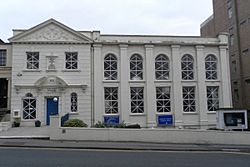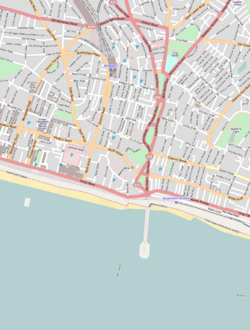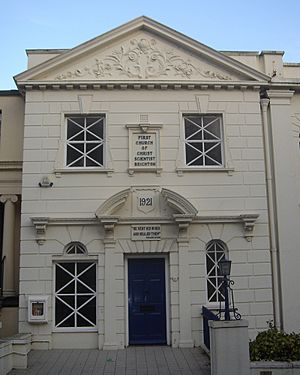First Church of Christ, Scientist (Brighton) facts for kids
Quick facts for kids First Church of Christ, Scientist |
|
|---|---|

The church from the west-northwest
|
|
| 50°49′34″N 0°09′07″W / 50.8261°N 0.1519°W | |
| Location | 97 Montpelier Road, Montpelier, Brighton and Hove BN1 3BE |
| Country | England |
| Denomination | Christian Science |
| Website | www.csbrighton.com |
| History | |
| Status | Church |
| Founded | 1921 |
| Architecture | |
| Functional status | Active |
| Architect(s) | Clayton & Black |
| Style | Regency/Neoclassical |
| Completed | 1921 |
The First Church of Christ, Scientist is a special building in Brighton and Hove, a city on the coast of England. It is used by people who follow the Christian Science faith. This building was once a large, fancy private house. In 1921, a famous local architecture company called Clayton & Black changed and added to it, turning it into the church you see today.
History of the Church Building
Montpelier was one of the first neighborhoods built in Brighton. It was developed between the 1820s and 1860s. This happened because Brighton was growing fast as a popular seaside town. Many houses were built in the 1840s and 1850s. Montpelier Road got rows of high-quality houses. These houses were covered in a smooth plaster called stucco. They were built in the Regency style. Number 97 Montpelier Road was built around 1850. It was at the south end of the road.
Before this building became a church, Christian Science followers met elsewhere. In the early 1900s, they gathered at the Athenaeum Recreation Hall. This hall was on North Street. It was a big place with several rooms. It could hold up to 500 people.
By 1921, the Christian Science group in Brighton was growing quickly. They needed a bigger place to worship. So, they bought 97 and 97a Montpelier Road. These had been two separate houses. The architects Clayton & Black were hired to combine them. They also added a new chapel to the south side. They made the entrance look grand in a Neoclassical style. This turned the houses into one large church building.
The church is officially listed as a place of worship. This means it is recognized by the government. It is also part of the Montpelier & Clifton Hill Conservation Area. This area is protected because it has many historic and beautiful buildings. The city council describes the church as a "notable" building. It helps make the street look attractive.
What the Church Looks Like
The Clayton & Black company started in the 1870s. By 1921, they had designed many different types of buildings. They used various styles. For the Montpelier Road church, they added a detailed Neoclassical front. The original house was a mix of Regency and Italianate styles. Some of its original features were kept.
The entire front of the church is covered in stucco. The entrance area has a special textured stone look called rustication. This entrance is on the left side. It has three sections, called bays. These sections are decorated with arched and straight windows. There is also a decorative band called a frieze. Above it is a "richly decorated pediment". This is a triangular shape often seen on old Greek or Roman buildings.
To the right, the main part of the chapel has five sections. These are separated by tall, flat columns called pilasters. The windows on the ground floor are flat at the top. The windows above them are arched. Inside the church, there is a gallery where people can sit. The area where the readers stand is decorated with wooden panels.
See also



